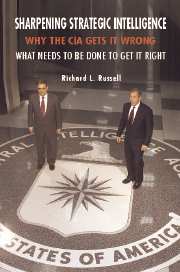 Sharpening Strategic Intelligence
Sharpening Strategic Intelligence Book contents
- Frontmatter
- Contents
- Acknowledgments
- Sharpening Strategic Intelligence
- 1 Strategic Intelligence and American Statecraft
- 2 Debunking Cold War Myths
- 3 Stumbling after the Cold War
- 4 Blundering in the “War on Terrorism”
- 5 Spies Who Do Not Deliver
- 6 Analysts Who Are Not Experts
- 7 Facing Future Strategic Intelligence Challenges
- Notes
- Selected bibliography
- Index
4 - Blundering in the “War on Terrorism”
Published online by Cambridge University Press: 26 July 2009
- Frontmatter
- Contents
- Acknowledgments
- Sharpening Strategic Intelligence
- 1 Strategic Intelligence and American Statecraft
- 2 Debunking Cold War Myths
- 3 Stumbling after the Cold War
- 4 Blundering in the “War on Terrorism”
- 5 Spies Who Do Not Deliver
- 6 Analysts Who Are Not Experts
- 7 Facing Future Strategic Intelligence Challenges
- Notes
- Selected bibliography
- Index
Summary
The united states suffered a huge intelligence failure on 11 September 2001 with the al-Qaeda attacks on the World Trade Center and the Pentagon and the failed attack that ended with an airplane crashing in a field in Pennsylvania. The events took the lives of some 3,000 American citizens. The intelligence community in general and the CIA in particular failed to detect al-Qaeda's intentions with the clarity needed to disrupt the attacks. The attacks set the United States off on what President Bush calls the “War on Terrorism,” a government policy that inaccurately lumps together U. S. efforts aimed at destroying al-Qaeda and the military campaign against the Taliban regime in Afghanistan with the Iraq War to oust Saddam Hussein's regime. Al-Qaeda and Iraq had been discrete strategic threats before 9/11 but were blurred together only after the 2003 toppling of Saddam's regime, which opened a power vacuum that al-Qaeda has sought to exploit by waging an insurgency in Iraq, much as jihadists had against the Soviet Union in Afghanistan during the 1980s. Be that as it may, no amount of debate or discussion is likely to separate the 9/11 events from the Iraq War, which have been drummed together as the War on Terrorism in the public's common mind.
The 9/11 attacks were in many ways reminiscent of the surprise attack on Pearl Harbor in 1941, which was instrumental in giving birth to the CIA as a central collection and analysis intelligence organization responsible for giving strategic warning of enemy attack to the commander in chief.
- Type
- Chapter
- Information
- Sharpening Strategic IntelligenceWhy the CIA Gets It Wrong and What Needs to Be Done to Get It Right, pp. 69 - 94Publisher: Cambridge University PressPrint publication year: 2007


